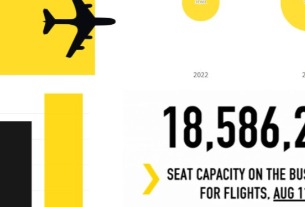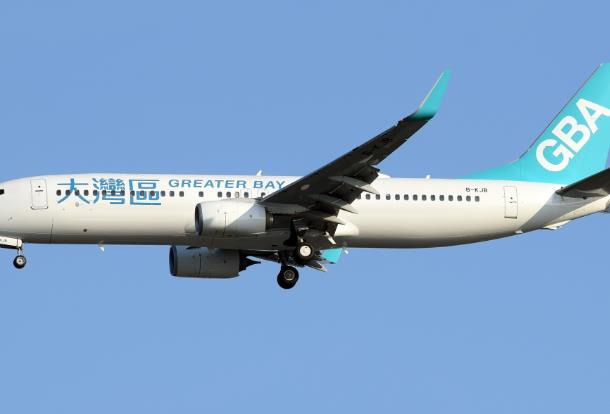Global view
In July 2014 there are 395 million scheduled global airline seats. This is an increase of 15.7 million, or 4% compared to July 2013. Flights have risen to 2.9 million, an increase of 2% compared to last July.
Just two regions will see a drop in seats. These are to/from Africa where there are 3% fewer seats than last year, or 334,060 seats. Capacity within North America will also see a decline of 0.3%, with carriers operating 225,856 fewer seats. While capacity to/from Africa has fallen, there is growth within the continent. Seats within Africa are up by 3% and frequencies are up by 2%. Similarly, while capacity within North America has declined fractionally, international markets are performing strongly with both seats and frequencies to/from North America up by 7%.
By volume of seats, the largest growth continues again to be within Asia/Pacific where the number of scheduled airline seats has grown by 7.8 million seats, or 6.6%, to just under 125 million seats in the month of July.
Gulf Carriers: Ever increasing circles?
With the news last month that Emirates have cancelled an order for 70 A350’s, we take the opportunity to review the big 3 Gulf carriers frequency in relation to aircraft type, and how their flight networks are spread out across the regions and in which markets they are currently pursuing growth.
In the month of July 2014, Emirates, Etihad and Qatar will operate just over 16,000 flights and 4.4 million seats from their respective Middle East hubs (DXB, AUH & DOH) to the rest of the world (one way). Between them, these carriers have increased flights by 5% since last July, and seats by 8%. While both Etihad and Qatar are growing both seats and flights, Emirates will record a drop in flights of 8% but an increase to seats of 1%. This is due to the combination of the use of larger aircraft as the A380 is rolled out
across parts of their network and the temporary grounding of some aircraft while the DXB runways undergo maintenance.
On many Middle East services, Emirates have switched services from A330 or A340 aircraft to B777s which in turn have been replaced on routes they operated by A380s. They have also trimmed frequency on many of these routes (AMM, BAH, BEY, DOH, JED, MCT and RUH) meaning their overall capacity within the Middle East is down.
Emirates are the world’s largest operator of the A380 and currently have 48 in service, with another 92 on order. The A380s operate mostly to Europe and Asia Pacific and the aircraft is used for 19% of Emirates’ flights in July 2014, an increase from 12% last July. However, the majority of services are still operated by their fleet of 136 B777s.
The Emirates A380s have 171 more seats than the B777 and this July sees the airline continue to add A380 capacity to airports in Western Europe, such as BCN, CDG, LGW, MUC and ZRH.
Emirates biggest destination region is Asia Pacific which accounts for 39% of their flights in July 2014. Of the big 3 Gulf carriers, Emirates have 44% of flights to Asia Pacific from the UAE and Qatar, and have the largest market share across all regions except for the Middle East.
Both Etihad and Qatar operate narrow-body and wide-body fleets, with over 50% of their respective flights operated on narrow-body aircraft, mostly to destinations within the Middle East, North Africa and Europe. Emirates, by contrast, have no narrow-body aircraft in their fleet, and consequently operate longer sectors – although perhaps surprisingly the average distance per flight in July across the Emirates network in July is 2,463 miles1, up from 2,361 last year.
The longest sector Emirates operate is DXB-LAX at 7,233 miles and just over 16 hours flying time. Despite operating aircraft capable of flying distances of up to 8,500 miles – 1 Miles relates to nautical miles meaning most of the world should be accessible from Dubai - 88% of Emirates’ July 2014 flights still operate to destinations within 4,000 miles of Dubai. This range equates to approximately 9 hours flying time or less and encompasses Europe, Africa and most of Asia as indicated by the shaded area on the map below.
Perhaps surprisingly, the amount of Emirates flights to destinations over 4,000 miles from DXB has only increased by 1 percentage point since last July. There are only 19 services to destinations beyond 4,000 miles with just one addition since last year, to Boston in the United States. The daily DXB-BOS service is the only growth Emirates will record in flights during July – services to all other regions are down.
The network map indicates that Latin America is still largely unserved by Emirates, with just two services to Brazil and nothing to the west coast. Routes such as DXB-LIM, or DXB-SCL are approximately 8,000 miles in distance, which would potentially push the A380 near the limit of its range, meaning these destinations may only become viable if and when Airbus deliver an A380 neo.
In the radar charts to the right we consider the development of Emirates network by direction over the last 5 years. In 2010, the data shows clearly the effect of Emirates early strategy of ‘one East, one West’ resulting in a fairly balanced network, whilst by 2013, the balance of services are clearly skewed North West, to Europe and North America. The 2014 chart also highlights the effect of the 8% reduction in flights vs July 2013.
The greatest volume of growth in new flights for the big Gulf three comes from the UAE and Qatar to Asia Pacific. The equivalent of 12 extra daily flights to the region are operating this July vs last year, with Etihad delivering the majority of that extra frequency and increasing their flights to the region by 40%.
In particular this growth is coming from services to India where Etihad have added 217 new flights vs last July. They have added a new service to Jaipur and doubled frequency to double daily services to 6 of their existing 9 Indian destinations. This is undoubtedly in response to the competitive play currently underway in the Indian market, and Etihad seem to be seeking to cement their position alongside their equity partner Jet Airways. Emirates, in contrast, already have a much bigger share of the market to India with 777 flights in July 2014 compared to Etihad’s 496.
Although almost approaching the level of frequency that Emirates operate, Qatar has a much smaller average aircraft size (40% lower than Emirates), and consequently operates about 61% of the capacity. Their main growth market is the Middle East where they will operate an extra 15 flights per day in July 2014 compared to July 2013, mostly on new services to DWC and SHJ.
So what impact will the cancellation of the A350 order have on Emirates plans for growth? In the short term, there will be none as the first of these aircraft weren’t scheduled for delivery until 2019. Meanwhile, Emirates retains its existing order for 60 B777s and a further 92 A380s which will provide plenty of capacity to meet market growth.
While there may be speculation that Emirates is attracted by the now proven lower operating costs of the B787 Dreamliner, the airline appears to be well placed with current aircraft in its fleet and those on order, to move into new growth markets as they emerge, whether they are truly long haul or are shorter routes where Emirates hub operations can drive the traffic density required to make the most of the wide-body fleet.




